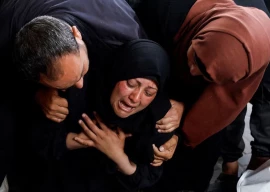
ISLAMABAD:
Floods caused by the current torrential rains have affected close to 3 million people and damaged around 2.2 million acres of crops across the four provinces — killing a total of 369 people so far.
According to initial estimates, some 200,000 people are awaiting shelter and relief goods — weeks after heavy flooding destroyed various districts across the country, officials dealing with natural disasters told The Express Tribune on Tuesday.
“The estimated damages to infrastructure and private and public property is around Rs250 billion in all four provinces,” revealed a senior official associated with the monitoring cell of the National Disaster Management Authority (NDMA).
In comparison, the 2010 floods had damaged crops and other infrastructure amounting over Rs800 billion.
“Over 369 people have lost their lives and 1,168 have been injured during the current floods,” initial estimates prepared by the NDMA stated.
Nearly 2 million acres of crops have been destroyed in all four provinces as well as Azad Kashmir (AJK) and Gilgit-Baltistan (G-B), with Sindh appearing to be the worst-hit province.
Over 12,559 cattle in total have perished and the current flash floods have forced over 600,000 people to take shelter in relief camps.
Sindh
In Sindh, a total of 1.6 million people have been affected and 0.8 million acres of crops have been partially or completely damaged. Around 138 persons have died so far, 600 injured, 0.25 million houses damaged, over 0.3 million acres lands affected and 7,000 cattle perished.
Balochistan
In Balochistan, nearly 80 people have died, 170 injured and 0.2 million houses completely destroyed leaving most of the affected households without shelter. The NDMA, however, is yet to assess the damages of crops and land in the province. Heavy rains have also damaged 40,000 houses, killing 5,056 cattle across the province and the Shahi canals system – a system to water crops in Nasirabad and Jaffarabad – has been destroyed.
Punjab and others
In Punjab, the floods have affected 0.6 million acres out the total 1.14 million acres of crops in various districts and 65 people have so far lost their lives. Nearly 320 have been injured, 503 cattle have perished, 25,453 houses washed away and over one million people affected in floods.
In Khyber-Pakhtunkhwa (K-P) 46 people have lost their lives, 56 injured, and 6,000 houses damaged.
Around 36 people have died in AJK, 40 injured, 2,500 houses damaged.
Five people have lost their lives in the federal capital as well. However, assessment regarding damages of cattle, crops and land is still going on in these areas.
Woes
Meanwhile, Balochistan has again complained to PM Raja Pervaiz Ashraf on Tuesday after not receiving any relief package from Islamabad despite repeated appeals.
“We have repeatedly urged Prime Minister Ashraf to declare all flood-hit districts of the province “calamity-hit” but he never listened to me,” said Federal Minister for Science and Technology Mir Chengez Khan Jamali.
“Today (Tuesday) I called him (Premier Ashraf). He promised to visit Balochistan on Saturday or Sunday to express solidarity with the flood victims,” he said.
Jamali once again appealed to the UN to contribute relief goods for flood victims in areas like Killa Saifullah, Dera Allah Yar Khan, Dera Murad Jamali and Dera Bugti — the worst-affected areas of the current monsoon rains.
Timo Pakkala, who is the UN’s resident coordinator in Pakistan, told The Express Tribune that the government has indicated that they have sufficient resources and would not require international assistance. “We, however, are undertaking an initial rapid assessment with the government in the affected areas to get a better picture.”
Published in The Express Tribune, September 19th, 2012.












































COMMENTS
Comments are moderated and generally will be posted if they are on-topic and not abusive.
For more information, please see our Comments FAQ